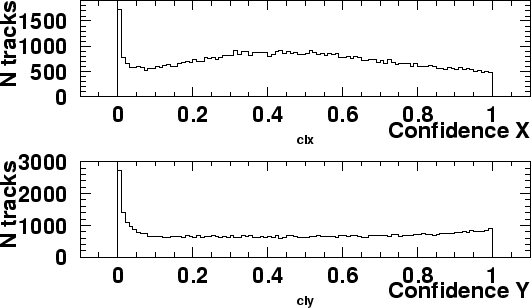



Next: Pad Chamber in the
Up: Track identification
Previous: Double beam cut
Contents
Kopytine's homepage
NA44 tracks particles in the volume behind the magnetic channel.
In the MUL1 (see subsection 3.4.3) runs,
the predominant majority of events are single track ones, and
our tracking situation is the simplest possible in a heavy ion experiment.
Which devices are used to track particles, and which information they
provide, is described in subsection 3.8.1.
The tracks are fitted with straight lines in three dimensions.
In the process, one obtains two  values (vertical and horizontal),
which, for given
number of degrees of freedom
values (vertical and horizontal),
which, for given
number of degrees of freedom  , characterize the quality of the fit.
For given
, characterize the quality of the fit.
For given  and
and  , we calculate the probability that a random
variable from a true
, we calculate the probability that a random
variable from a true  distribution with given
distribution with given  happens to be larger than the given
happens to be larger than the given  value.
value.
Figure 4.8:
Track confidence level distribution in the positive strong field,
high angle, pion trigger setting. Top: confidence level distribution in  .
Bottom: confidence level distribution in
.
Bottom: confidence level distribution in  .
.
 |
Examples of such distributions are shown in Fig. 4.8.
We call this probability a confidence level,
cut on it from below and call that a confidence level cut,
or  -cut.
In experimental data (and in a realistic MC), due to a number of instrumental
imperfections (detector off-set, fake hits, inefficiencies) and deviations
of the real tracks from the idealistic fitting model (decays, conversions,
multiple scattering) the percentage of tracks actually rejected by a
sufficiently low
-cut.
In experimental data (and in a realistic MC), due to a number of instrumental
imperfections (detector off-set, fake hits, inefficiencies) and deviations
of the real tracks from the idealistic fitting model (decays, conversions,
multiple scattering) the percentage of tracks actually rejected by a
sufficiently low  -cut is much higher than what the ``nominal'' value
of the confidence level implies.
-cut is much higher than what the ``nominal'' value
of the confidence level implies.
To get rid of the unreliable tracks in the off-line analysis of the experimental
data, I rejected tracks with either vertical or
horizontal  .
To evaluate the probability for a real track to be lost as a result of that,
I ran MC simulation (thus modeling some of the imperfections mentioned above),
and found out that the combined 2D
.
To evaluate the probability for a real track to be lost as a result of that,
I ran MC simulation (thus modeling some of the imperfections mentioned above),
and found out that the combined 2D  -cut retains from
83% to 87% of the good tracks, slightly depending on the setting used.
The corresponding corrections (known with 4 digit precision)
were applied for each setting.
-cut retains from
83% to 87% of the good tracks, slightly depending on the setting used.
The corresponding corrections (known with 4 digit precision)
were applied for each setting.




Next: Pad Chamber in the
Up: Track identification
Previous: Double beam cut
Contents
Mikhail Kopytine
2001-08-09


![]() .
To evaluate the probability for a real track to be lost as a result of that,
I ran MC simulation (thus modeling some of the imperfections mentioned above),
and found out that the combined 2D
.
To evaluate the probability for a real track to be lost as a result of that,
I ran MC simulation (thus modeling some of the imperfections mentioned above),
and found out that the combined 2D ![]() -cut retains from
83% to 87% of the good tracks, slightly depending on the setting used.
The corresponding corrections (known with 4 digit precision)
were applied for each setting.
-cut retains from
83% to 87% of the good tracks, slightly depending on the setting used.
The corresponding corrections (known with 4 digit precision)
were applied for each setting.